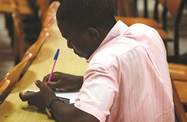Initiatives to extend finance to students at university and expand access to ICT are helping to strengthen Tanzania’s education system.

In mid-August two NGOs – the Tanzania Social Support Foundation (TSSF) and the Cosmopolitan Development Foundation – inked a deal to provide loans to more than 50,000 students enrolled at higher education institutions across the country.
Under the programme, more than $1m will be made available for students living in difficult circumstances at the beginning of the new academic year and will be disbursed under conditions similar to those of the Higher Education Students’ Loans Board, according to local media reports.
Increase in student numbers produces funding gaps
The initiative was launched by TSSF to fill the shortfall of loans provided by the government to tertiary-level students.
Roughly 60,000 pupils each year are unable to take advantage of state assistance for tertiary education, due largely to a rise in both student volumes and the number of institutions opening their doors. The number of students attending higher education institutions rose 83% from the 2009/10 academic year to 224,000 in 2014/15.
With annual tuition fees for higher education degrees costing TSh2m-3m ($890-1336) and gross national income per capita around $900 per year, according to the World Bank, funding support is essential for many families to make further education affordable.
Easing financial constraints forms part of a national drive to make education more accessible to students of all ages. In May the World Bank approved an $80m credit line to help provide quality education at the primary and secondary level as part of Circular 5, under the government’s Fee Free Basic Education Policy, introduced in December 2015. According to the announcement, the financing “aims to support the government’s effort to manage the challenges accommodating the surge in primary and lower secondary students” that followed the programme’s introduction.
Free lower-level schooling is also being supported by the UK, which is investing £150m between 2013 and 2020 to enhance the quality and accessibility of education, particularly for girls and children with disabilities.
Budget targets a stronger education system
Efforts to strengthen education in Tanzania are also reflected in increased levels of government spending. The government committed TSh4.77trn ($2.12bn) to education in the FY 2016/17 budget – nearly one-quarter (22.1%) of total expenditure. The allocation has remained the same since FY 2014/15, but is still higher than some of the country’s regional peers, such as Kenya, which set aside 16.5% of total public expenditure for education in 2015, according to the UNESCO Institute for Statistics.
The FY 2017/18 draft budget – which has yet to receive approval – outlines multiple initiatives aimed at strengthening the entire education system, from primary school to tertiary level. These efforts include rehabilitating existing school infrastructure, training additional teachers to meet growing demand for education and enhancing inspection to ensure the quality of instruction. Other plans in the budget include identifying sustainable financing sources for free basic education, and increasing the use of ICT in teaching and learning.
Key role for technology in modernising education
The use of ICT for educational purposes is gaining traction, particularly as a means of reaching rural areas and enabling students to make use of less traditional methods of learning.
In May Herb Rhee, the director of South Korea’s Innovative Technology and Energy Centre (ITEC) announced plans to open a training institute focused on renewable energy technology in Arusha. Aimed at primary and secondary students, the facility will have the capacity to educate 1000 students per year on green energy technologies, particularly solar panels, once fully operational.
The ITEC has already provided ICT training to 300 secondary school students in Arusha, as well as 200 primary and secondary school teachers, with the aim of building up expertise in renewable energy in order to expand energy access to rural areas of the country.
Students located outside the major cities are also gaining access to education through the developing e-learning industry. One online learning platform, Shule Direct, provides study tools to secondary students in line with national curricula. According to the service’s website, the enterprise has over 20,000 registered students.
E-learning platforms also allow teachers to streamline their courses more efficiently, making it easier for them to reach students throughout the country. Teachers using Shule Direct, for example, can create digital notes, tutorials, podcasts and videos that can be shared with a wider audience.
However, accessing these and other tools requires a strong and stable internet connection, which is lacking in some parts of the country. In 2016 Tanzania’s internet penetration rate stood at 40%. Plans are in place to improve penetration levels. However, in the interim, goals set out by the Powering Potential project aim to provide offline digital educational resources in order to reach more learners. Launched in 2006, Powering Potential is a local initiative that seeks to provide schools in rural regions with solar power, technology training and computers with an offline digital library.


